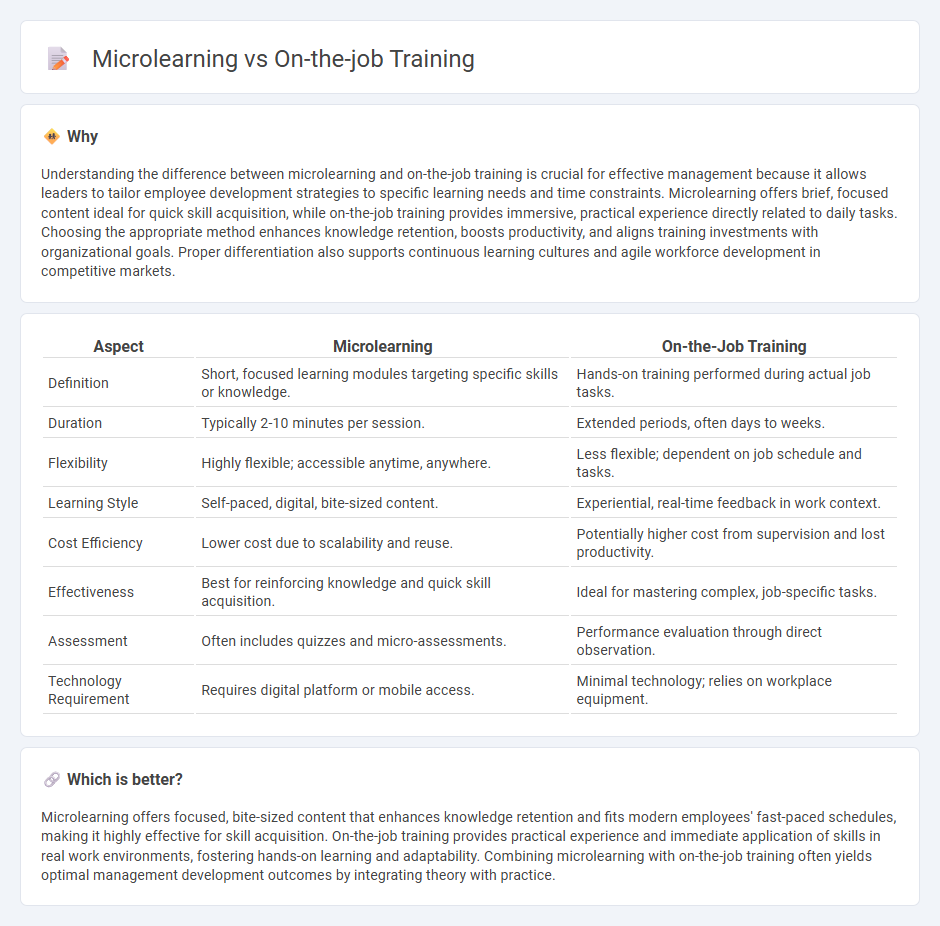
Microlearning delivers focused, bite-sized content designed to enhance retention and fit into busy schedules, making it ideal for quick skill acquisition. On-the-job training offers hands-on experience, enabling employees to apply knowledge in real-time within their work environment for practical skill development. Explore the benefits and applications of both methods to determine which approach best suits your organizational training needs.
Why it is important
Understanding the difference between microlearning and on-the-job training is crucial for effective management because it allows leaders to tailor employee development strategies to specific learning needs and time constraints. Microlearning offers brief, focused content ideal for quick skill acquisition, while on-the-job training provides immersive, practical experience directly related to daily tasks. Choosing the appropriate method enhances knowledge retention, boosts productivity, and aligns training investments with organizational goals. Proper differentiation also supports continuous learning cultures and agile workforce development in competitive markets.
Comparison Table
| Aspect | Microlearning | On-the-Job Training |
|---|---|---|
| Definition | Short, focused learning modules targeting specific skills or knowledge. | Hands-on training performed during actual job tasks. |
| Duration | Typically 2-10 minutes per session. | Extended periods, often days to weeks. |
| Flexibility | Highly flexible; accessible anytime, anywhere. | Less flexible; dependent on job schedule and tasks. |
| Learning Style | Self-paced, digital, bite-sized content. | Experiential, real-time feedback in work context. |
| Cost Efficiency | Lower cost due to scalability and reuse. | Potentially higher cost from supervision and lost productivity. |
| Effectiveness | Best for reinforcing knowledge and quick skill acquisition. | Ideal for mastering complex, job-specific tasks. |
| Assessment | Often includes quizzes and micro-assessments. | Performance evaluation through direct observation. |
| Technology Requirement | Requires digital platform or mobile access. | Minimal technology; relies on workplace equipment. |
Which is better?
Microlearning offers focused, bite-sized content that enhances knowledge retention and fits modern employees' fast-paced schedules, making it highly effective for skill acquisition. On-the-job training provides practical experience and immediate application of skills in real work environments, fostering hands-on learning and adaptability. Combining microlearning with on-the-job training often yields optimal management development outcomes by integrating theory with practice.
Connection
Microlearning enhances on-the-job training by delivering concise, focused content that employees can immediately apply in real work scenarios. This approach improves retention and skill acquisition by breaking down complex tasks into manageable learning segments tailored to specific job roles. Integrating microlearning within on-the-job training programs boosts productivity and fosters continuous professional development in dynamic work environments.
Key Terms
Experiential Learning
On-the-job training immerses employees in real-world tasks, fostering experiential learning through hands-on practice and immediate application of skills, which enhances knowledge retention and problem-solving abilities. Microlearning delivers focused, bite-sized content that complements experiential learning by providing just-in-time information to reinforce specific competencies without overwhelming the learner. Explore more about how integrating experiential learning in both approaches boosts workforce development and performance.
Bite-sized Content
On-the-job training offers hands-on experience but often requires extended time for skill acquisition, whereas microlearning delivers bite-sized content tailored for quick, focused learning sessions. Microlearning modules typically range from 2 to 10 minutes, making knowledge retention more efficient through concise, targeted lessons that fit seamlessly into the workday. Explore our expert insights to discover how integrating bite-sized content can elevate your corporate training strategy.
Skill Application
On-the-job training emphasizes real-time skill application by immersing employees directly in work tasks, promoting hands-on learning and immediate feedback. Microlearning delivers concise, focused content in short bursts, enabling quick reinforcement of skills and adaptability to busy schedules. Explore detailed insights to determine which approach best enhances practical skill development in your organization.
Source and External Links
On-the-job training: Meaning and Best Practices - This webpage describes on-the-job training as a method of teaching employees new skills while they perform their job duties, often facilitated by experienced employees or supervisors.
On-the-job training - On-the-job training is a form of training provided at the workplace, where employees learn by hands-on experience using machinery and equipment under the guidance of experienced mentors.
On-the-Job Training - This program allows unemployed individuals to earn a paycheck while gaining job-specific training and real work experience in a real work environment.
 dowidth.com
dowidth.com